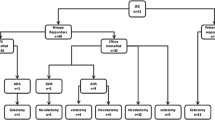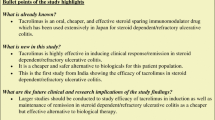Abstract
Background
There is no agreeing if rescue therapy can avoid short-term colectomy in patients treated for severe steroid-refractory ulcerative colitis.
Aims
The aim of our study was to identify predictors of response to infliximab and cyclosporine A.
Methods
In this cross-sectional study, 49 patients with severe ulcerative colitis were included. Response to therapy was defined as three or more point reductions in Mayo score after 6 months of treatment and avoidance of colectomy after 1 year. The predictors analysed were gender, age, time from ulcerative colitis diagnosis, months of steroid or/and azathioprine therapy before onset of the severe phase, smoking habits, extension of the disease, laboratory analyses and Mayo score.
Results
Patients treated with infliximab showed a statistically significant higher response rate in case of moderate Mayo score (P = 0.04). Ex-smokers had very low chance of response to infliximab (P = 0.03). In the group treated with cyclosporine A, patients with C-reactive protein >3 mg/L had a response rate significantly higher than those with C-reactive protein <3 mg/L (P = 0.03); those with negative C-reactive protein and moderate Mayo score did not responded to therapy, while in the ones with elevated C-reactive protein and/or severe Mayo score, 15 versus 4 responded (P = 0.008).
Conclusions
Our data suggest that cyclosporine A is advisable in ex-smokers. In never smokers or active smokers, infliximab can be prescribed in case of Mayo score ≤10 and/or negative CRP, while cyclosporine A is indicated in case of Mayo score >10 and positive CRP.






Similar content being viewed by others
References
Dignass A, Eliakim R, Magro F et al (2012) European evidence-based consensus on the diagnosis and management of ulcerative colitis part 1: definitions and diagnosis. J Crohns Colitis 6:965–990
Peyrin-Biroulet L, Panés J, Sandborn WJ et al (2016) Defining disease severity in inflammatory bowel diseases: current and future directions. Clin Gastroenterol Hepatol 14:348–354.e17
Danese S, Fiocchi C (2011) Ulcerative colitis. N Engl J Med 365:1713–1725
Actis GC, Pellicano R (2016) The pathologic galaxy modulating the genotype and phenotype of inflammatory bowel disease: co-morbidity, contiguity, and genetic and epi-genetic factors. Minerva Med 107:401–412
Etchevers MJ, Aceituno M, Garcia-Bosch O et al (2009) Risk factors and characteristics of extent progression in ulcerative colitis. Inflamm Bowel Dis 9:1320–1325
Tremaine WJ, Sandborn WJ (1999) Practice guidelines for inflammatory bowel disease: an instrument for assessment. Mayo Clin Proc 74:495–501
Travis SP, Stange EF, Lémann M et al (2008) European evidence-based consensus on the management of ulcerative colitis: current management. J Crohns Colitis 2:24–62
Bennis M, Tiret E (2012) Surgical management of ulcerative colitis. Langenbeck's Arch Surg 397:11–17
Koltun WA (2009) Role of medical rescue therapy in the management of acute severe ulcerative colitis: the surgical perspective. Expert Rev Gastroenterol Hepatol 3:325–327
Campbell S, Travis S, Jewell D (2005) CyclosporineA use in acute ulcerative colitis: a long-term experience. Eur I Gastroenterol Hepatol 17:79–84
Rutgeerts P, Sandborn WJ, Feagan BG et al (2005) Infliximab for induction and maintenance therapy for ulcerative colitis. N Engl J Med 353:2462–2476
Van Assche G, Vermeire S, Rutgeerts P (2011) Management of acute severe ulcerative colitis. Gut 60:130–133
Lees CW, Heys D, Ho GT et al (2007) A retrospective analysis of the efficacy and safety of infliximab as rescue therapy in acute severe ulcerative colitis. Aliment Pharmacol Ther 26:411–419
Mocciaro F, Renna S, Orlando A et al (2012) Cyclosporine A or infliximab as rescue therapy in severe refractory ulcerative colitis: early and long-term data from a retrospective observational study. J Crohns Colitis 6:681–686
Actis GC, Fadda M, David E et al (2007) Colectomy rate in steroid-refractory colitis initially responsive to cyclosporin: a long-term retrospective cohort study. BMC Gastroenterol 7:13
Pinna-Pintor M, Arese P, Bona R et al (2000) Severe steroid-unresponsive ulcerative colitis: outcomes of restorative proctocolectomy in patients undergoing cyclosporin treatment. Dis Colon Rectum 43:609–613
Truelove SC, Witts LJ (1955) Cortisone in the treatment of ulcerative colitis. Final report of a therapeutic trial. Br Med J 2:1041–1048
Schroeder KW, Tremaine WJ, Ilstrup DM (1987) Coated oral 5-aminosalicylic acid therapy for mildly to moderately active ulcerative colitis. A randomized study. N Engl J Med 317:1625–1629
Subramaniam K, Richardson A, Dodd J et al (2014) Early predictors of colectomy and long-term maintenance of remission in ulcerative colitis patients treated using anti-tumour necrosis factor therapy. Intern Med J 44:464–470
Aratari A, Papi C, Clemente V et al (2008) Colectomy rate in acute severe ulcerative colitis in the infliximab era. Dig Liver Dis 40:821–826
Nuij V, Fuhler GM, Edel AJ et al (2015) Benefit of earlier anti-TNF treatment on IBD disease complications? J Crohns Colitis 9:997–1003
Author information
Authors and Affiliations
Contributions
Saracco G, Astegiano M, Pellicano R, Dileo I and Ribaldone DG designed the research; Dileo I, Fagoonee S and Vernero M performed the research; Vernero M and Fagoonee S analysed the data; Dileo I GA, Ribaldone DG, Astegiano M and Pellicano R wrote the paper. All authors have approved the final article.
Corresponding author
Ethics declarations
This article does not contain any studies with human participants performed by any of the authors. Informed consent was obtained from all individual participants included in the study.
Conflict of interest
The authors declare that they have no conflict of interest.
Supported by: None.
Rights and permissions
About this article
Cite this article
Ribaldone, D.G., Dileo, I., Pellicano, R. et al. Severe ulcerative colitis: predictors of response and algorithm proposal for rescue therapy. Ir J Med Sci 187, 385–392 (2018). https://doi.org/10.1007/s11845-017-1666-0
Received:
Accepted:
Published:
Issue Date:
DOI: https://doi.org/10.1007/s11845-017-1666-0




